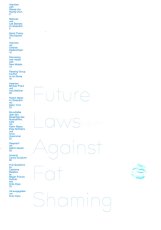|
Titel
-
From Here On - A partir de maintenant ...
Technische
Angaben
-
42x30 cm, ISBN/ISSN 9782953916812
Drahtheftung,
ZusatzInfos
-
Presented as a manifesto at the Rencontres d’Arles Photography Festival in Arles, on occasion of the exhibition "From Here On", July 4 – September 18, 2011, curated by Clément Chéroux, Joan Fontcuberta, Erik Kessels, Martin Parr, and Joachim Schmid. From Here On included the work of thirty-six international artists who appropriate popular imagery from the Internet using vernacular sources from social media, search engines, archives, and surveillance.
Text Website
|
Technische
Angaben
-
176 S., 27x18 cm, ISBN/ISSN 9788480265300
Softcover, Broschur, Schutzumschlag aus Noppenfolie,
ZusatzInfos
-
Publikation zur gleichnamigen Ausstellung vom 10.11.2015-21.03.2016.
A conversation between Hito Steyerl and João Fernandes, curator of the exhibition, an essay by Carles Guerra and Steyerl herself, introduced us to one of the most relevant contemporary artists in the field of Video art. Steyerl approaches current themes in her work, for instance the impact the proliferation of images and the use of the Internet and technology have on our lives. She uses these issues as a starting point for developing, not just through her video pieces but also through writing and essays, critical work about control, surveillance and militarisation, migration, cultural globalisation, feminism and political imagery, questions she believes have the capacity to create realities.
Text von Website
|
Titel
-
Surveillance. Solutions for you.
Technische
Angaben
-
[12] S., 29,6x21 cm, 2 Stück. keine weiteren Angaben vorhanden
Drahtheftung
ZusatzInfos
-
Publikation/partizipatives Projekt von Niels Lomholt anlässlich der Ausstellung "Im Inneren der Stadt, Inside the City", 19.07.-11.10.2015, Studienzentrum für Künstlerpublikationen Weserburg, Bremen
|
Technische
Angaben
-
[72] S., 14,8x10,5 cm, Auflage: 100, keine weiteren Angaben vorhanden
Digitaldruck S/W, Softcover, Klebebindung, mit Bauchbinde
ZusatzInfos
-
Fotografien während eines Aufenthalts im Art Peace Hotel Shanghai. Schlagzeilen aus der "China Daily", 5/6 2018. “In springtime 2018 I spent a few weeks inside the modern world’s dystopian dream, living under constant video surveillance and being identified by face recognition software wherever I went. The authorities aim to control everybody and everything with an ever-growing number of cameras. The daily paper informed me of whatever anomalies the omnipresent cameras recorded and also what had escaped them. Art Peace China Daily is the report of my sojourn in this country.”
Text von der Webseite
|
Titel
-
BEFORE AND AFTER - DOCUMENTING THE ARCHITECTURE OF DISASTER
Technische
Angaben
-
72 S., 23,5x19 cm, Auflage: Print on Demand, ISBN/ISSN 9780992914691
Broschur, Fehldruck, Inhalt zweimal eingebunden, letzte Seite falsch beschnitten
ZusatzInfos
-
A nuclear facility in Iran before and after an explosion, a village in Pakistan before and after a drone attack, a Cambodian river valley before and after a flood. The before-and-after image has become the tool of choice for analysing events.
Satellite photography allows us to scrutinise the impact of war or climate change, from the safe distance of orbit. But one thing is rarely captured: the event itself. All we can read is its effect on a space, and that’s where the architectural expert is required, to fill the gap with a narrative. In this groundbreaking essay, Eyal and Ines Weizman explore the history of the before-and-after image, from its origins in 19th-century Paris to today’s satellite surveillance. State militaries monitor us and humanitarian organisations monitor them. But who can see in higher resolution? Who controls the size of the pixels? Interpreting these images is never straightforward.
Text von der Webseite
|
Titel
-
Watched! - Surveillance, art and photography
Technische
Angaben
-
295 S., 24,9x29 cm, ISBN/ISSN 9783863359591
Hardcover, Graupappe
ZusatzInfos
-
Die Ausstellung ist ein Kooperationsprojekt der Hasselblad Foundation, der Valand Academy, der Kunsthal Aarhus und C/O Berlin. Sie wurde kuratiert von Louise Wolthers und Dragana Vujanovic (Hasselblad Foundation), Niclas Östlind (Valand Academy) sowie Ann-Christin Bertrand (C/O Berlin). Sie ist Teil eines von der Hasselblad Foundation initiierten Projekts zu Überwachung, Kunst und Fotografie in Europa nach der Jahrhundertwende. Die begleitende Publikation, erschienen in der Verlagsbuchhandlung Walther König, enthält Kunstwerke von vierzig Künstlern, daneben Aufsätze von zahlreichen Wissenschaftlern und wurde erst im November vom Time Magazine in der Kategorie „Best Photobooks of 2016“ ausgezeichnet.
Überwachung total? Videokameras in Banken, Kaufhäusern und an öffentlichen Plätzen, von Algorithmen gesteuerte Werbung und persistente Cookies im Internet, staatliche Vorratsdatenspeicherung und private Cloud-Speicherdienste – im Alltag sind permanente Beobachtung und Data Sharing heute selbstverständlich. Tagtäglich nutzen wir Dienste wie Google Maps, schauen uns Live-Streams an und begeistern uns über Health-Apps und ungeahnte Möglichkeiten der Selbstkontrolle. Wir verfolgen unsere Freunde und wildfremde Menschen auf Facebook, Twitter und Instagram und werden selbst kontinuierlich getrackt. Wir profitieren von den neuen digitalen Techniken und Angeboten und sind dafür bereit, unser Privatleben immer öffentlicher werden zu lassen. Überwachung und Big Data sind längst zu einem großen gesellschaftlichen Thema geworden.
Text von der Webseite
|
Titel
-
Corner Surveillance + 24/7 Photography
Technische
Angaben
-
[2] S., 21x10,5 cm, 2 Stück. keine weiteren Angaben vorhanden
Postkarte
ZusatzInfos
-
Einladungskarte zur Ausstellung einer 3-Kanal Closed-Circuit Videoinszenierung, 18.01.-23.02.2019.
Bei der 3-Kanal Vidoeinszenierung von Alexander Steig werden drei Überwachungskameras ihrer Funktion durch eine 180-Grad-Drehung enthoben und übertragen nun die Raumecken auf drei Projektionsflächen im Ausstellungsbereich. Die Rauminszenierung verbindet Video, Malerei und Skulptur und berührt das Thema der medialen Überwachung. Zur Eröffnung am 17. Januar um 19 Uhr hält der Künstler eine Einführung.
Alexander Steig arbeitet seit Mitte der 1990er Jahre mit den sogenannten Neuen Medien, vorzugsweise mit dem Closed-Circuit-Verfahren. Bei seinen ereignisarmen Bildern spielen Licht, Schatten und Reflexion wie auch Dekonstruktion, Manipulation und Dekontextualisierung vorgefundener Motive eine wesentliche Rolle.
Text von der Webseite
|
Titel
-
Corner Surveillance + 24/7 Photography
Technische
Angaben
-
[16] S., 14,8x21 cm, Auflage: 500, 2 Stück. ISBN/ISSN 9783928804943
Drahtheftung
ZusatzInfos
-
Zur Ausstellung einer 3-Kanal Closed-Circuit Videoinszenierung, 18.01.-23.02.2019 in der Arthotek & Bildersaal - ein Kunstraum der Stadt München.
Bei der 3-Kanal Vidoeinszenierung von Alexander Steig werden drei Überwachungskameras ihrer Funktion durch eine 180-Grad-Drehung enthoben und übertragen nun die Raumecken auf drei Projektionsflächen im Ausstellungsbereich. Die Rauminszenierung verbindet Video, Malerei und Skulptur und berührt das Thema der medialen Überwachung. Zur Eröffnung am 17. Januar um 19 Uhr hielt der Künstler eine Einführung.
Alexander Steig arbeitet seit Mitte der 1990er Jahre mit den sogenannten Neuen Medien, vorzugsweise mit dem Closed-Circuit-Verfahren. Bei seinen ereignisarmen Bildern spielen Licht, Schatten und Reflexion wie auch Dekonstruktion, Manipulation und Dekontextualisierung vorgefundener Motive eine wesentliche Rolle.
Text von der Webseite
|
Titel
-
Fotografija NR. 1 (35) 2018
Technische
Angaben
-
[116] S., 27,5x23 cm, ISBN/ISSN 16487273
Broschur
ZusatzInfos
-
We are heading into a future where our choices will be shaped – if not outright determined – by algorithms and artificial intelligence. This coming state has been labelled “the new dark age” (James Bridle, 2018).
It remains to be seen what this brings to photography, and vice versa.
One thing, however, seems clear: photography, which has already changed significantly in the 21st century, is affected by – and in some important ways is part of – this development. This issue of “Fotografija” explores how programmes, apps and AI-related technologies shape and change the discourse of photography, challenging traditional boundaries of the medium.
Various programmes and services – Google, Photoshop, Flickr, Snapchat, visual recognition, etc. – provide new tools to conceive image-making and think photographically. Technological interfaces not only deliver instruments for making work but can become the very logic for creating photographic series.
The presented artists offer perspectives to raise questions and discuss these technological shifts. From dealing with traumatic events (Indrė Šerpytytė) and inaccessible sites (James Bridle) through technological mediation to playing with our expectations of an all-pervasive Photoshop manipulation (Erin E’Keefe). From exploring so-called smart surveillance systems (Esther Hovers) and censoring politically sensitive sites (Mishka Henner) to everyday glitches (Mantas Grigaitis). From playing with the copyrights of such collective websites as Flickr (Penelope Umbrico) to exploring the shared language of being in some of the most photographed places on earth (Thomas Albdorf). And from using Photoshop to create images (Aaron Hegert) to an image that is barely photographic (Zachary Dean Norman). The four essays (Kate Palmer Albers, Roksana Filipowska and Marijana Rayl, Ilaria Speri, Alise Tifentale) map out the works in broader social, historical and art contexts.
In short, the works deal with our technologized world. They talk about being in the middle of changes that few have envisioned. Being so immersed, one can feel it (almost) hurts.
Text von Paul Paper.
|

Technische
Angaben
-
[94] S., 25,3x20 cm, ISBN/ISSN 9780986908941
Broschur, Laserdruck
ZusatzInfos
-
Lone Wolf is a picture book whose name is derived from the provision of the U.S.A. Patriot act which seeks to create a legal framework that allows the government to surveil individuals not associated with any group or country who are believed to be engaged in terrorist activities. Comprised of screenshots from reality television shows depicting expressions of physical force within three sectors of american society: police, local militia, and the U.S. military, excerpts from congressional hearings of the 112th and 113th congresses on the Patriot act give context to the images. The photographic images have been converted into large halftone dot compositions, which might imply an information flow—or lack of—that exposes the roots of suspicion and intolerance that culminate in statements like “see something, say something.”
"Texts from 'Let there be light,' directed by John Huston, 1946, and four congressional hearings on the USA Patriot Act between 2009 and 2011 (111th and 112th Congress). Images from various reality television shows including Cops, Moonshiners, Sons of Guns, The Colony, American Guns and Alaska State Troopers, as well as Flickr.com"--Colophon
Title based on the Lone Wolf provision on surveillance in the USA Patriot Act.
Texte von verschiedenen Webseiten.
|
Titel
-
Future Laws Against Fat Shaming
Technische
Angaben
-
40 S., 42x29,7 cm, keine weiteren Angaben vorhanden
Drahtheftung, rückseitig metallicblaue gesprayte Flecken
ZusatzInfos
-
Future Laws Against Fat Shaming revolves around the question of what happens to the body on the Internet, in a public sphere where encounters increasingly take place digitally, online.
Between July and September 2020, in a series of interviews and discussions Anke Dyes explored this issue, dealing with concepts such as body positivity, cancelling, CGI, coming-out, fat activism, corporeality, laws, habits, haterism, intention, cats, conflicts, marginalization, micro-actions, narcissism, passivity, social media, statistics, surveillance, repetition, and the Internet’s age of inquisition.
Future Laws Against Fat Shaming dreht sich um die Frage, was mit dem Körper im Internet geschieht, in einer öffentlichen Sphäre, in der Begegnungen zunehmend digital, online stattfinden.
Zwischen Juli und September 2020 untersuchte Anke Dyes in einer Reihe von Interviews und Gesprächen diese Frage und befasste sich mit Begriffen wie Body Positivity, Cancelling, CGI, Coming-out, Fat Activism, Körperlichkeit, Gesetze, Gewohnheiten, Haterismus, Absicht, Katzen, Konflikte, Marginalisierung, Mikro-Aktionen, Narzissmus, Passivität, soziale Medien, Statistiken, Überwachung, Wiederholung und das Zeitalter der Inquisition im Internet.
Übersetzt mit DeepL
|






















